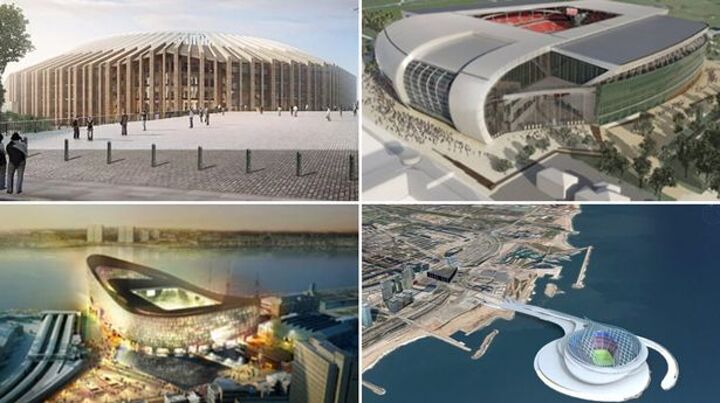Although Europe boasts some of the most breathtaking and historic football pitches in the world, these stunning designs unfortunately never caught on.
Big stadiums have always been a boon to European football, whether it's the Theater of Dreams Old Trafford, the Bernabeu, Camp Nou or San Siro. And in recent years, modern genius has also prevailed.
Tottenham Hotspur Stadium is now the benchmark for new grounds in England, with more than 60,000 seats, a retractable NFL pitch and a microbrewery. However, there have been many projects that shared a similar splendor, but unfortunately would not be.
Mirror Football explores the European terrain, including a bizarre UFO design that promised to be special, but unfortunately never saw the ball rolling.
Chelsea
With more than 40,000 spectators on the grounds of the two-time Champions League winner, the expansion of Stamford Bridge has been on Chelsea's agenda for some time – and will remain so.
In 2012, former owner Roman Abramovich took action and submitted a bid to buy the then-abandoned Battersea Power Station, located on the south bank of the River Thames.
Sadly, the Grade II listed building would not fall into the hands of the Blues as Abramovich and Co were outbid, and the stunning drawings incorporating the building's four iconic chimneys were left to ponder like a dream.
However, three years after their failed bid, a new Stamford Bridge design would arrive, drawn up by Swiss architectural firm Herzog and de Meuron. But now, with Abramovich in the club's rear-view mirror, plans have gone on and off, although they are still in the pipeline, with a move away from Earls Court a possible option.
Liverpool
Liverpool, another club looking to close the gap on their rivals with a larger ground, unveiled plans in 2007 to build a brand new 60,000-seat stadium in the adjacent Stanley Park.
The then owners Tom Hicks and George Gillett were keen on the idea, but Liverpool City Council was not and the plan was later scrapped.
However, this has not stopped the Reds from reaching the 60,000 seat mark at Anfield, as the Anfield Road stand of their current stadium was expanded last season, adding an additional 7,000 seats.
Everton
Like their city rivals, Everton also came up with plans for a new stadium in the mid-1990s: a 50,000-seat gem at Kings Dock.
Yet the similarities between the Toffees and Reds remain as the said £150m plan – the club's third attempt at a move – was rejected by the government.
However, the rebuttals stopped in 2020 when Liverpool City Council approved Everton's Bramley-Moore Dock scheme. Ground was broken in 2021 and this current season will be the club's final season at Goodison Park as they move to their new 52,888-seater home for the 2025/26 season.
Another outrageous plan once proposed and ultimately avoided was an adjacent stadium for both Everton and Liverpool, located in Stanley Park. This 'Siamese Stadium' plan was put forward by a consortium in 2010 and, perhaps fortunately for both groups of fans, never came to fruition.
Portsmouth
Herzog and de Meuron, who helped with Chelsea's initial designs, also presented plans for Portsmouth's 36,000 ground at Portsea in 2007. The models projected a beautiful waterfront site, but reality would be much less forgiving.
A £600 million project involving not only the stadium was reprimanded, and even moving to another area on Hornsea Island, due to the backdrop of the 2008 global financial crisis, Fratton Park would remain their home.
“The harborside stadium was a fantastic design, absolutely beautiful,” former Portsmouth chief executive Peter Storrie told The Athletic. 'It would have been perfect.
“It was there on the waterfront. They put it on the screen for us and it definitely had the wow factor. It would have been an iconic location. One of the great stadiums if it were built.”
Dinamo Zagreb
This volcano-shaped monstrosity has never left Photoshop, and fans are probably happy that this site, dubbed the Blue Volcano by the press, remains buried. The 'cloud-covered' eco-friendly stadium would have had a capacity of 55,000.
Barcelona
La Blaugrana began the expansion and modernization of their iconic Camp Nou after the 2022/23 La Liga season. Although it is expected to be completed in June 2026, with a total capacity of 105,000 people and a new retractable roof, there was once a plan to move to the sea.
Connected by a bridge, a 150,000-seat mega-stadium was proposed before the club's final renovation – a project that would have taken the crown as the most ambitious yet remarkable on the continent.
Bristol city
In 2007, the same year that Portsmouth were attempting to get their new project off the ground, Bristol City announced their proposal to replace Aston Gate with a 42,000-seat building, to be built on land in Ashton Vale.
Yet their position was not allowed to be that way either. An application from local residents recommended that the area be registered as an urban green space, meaning its future use was limited and could not be developed.
The club therefore decided to scrap their plans, but went ahead with a renovation of Ashton Gate in 2016. This increased the stadium's capacity from 16,600 to 27,000.
